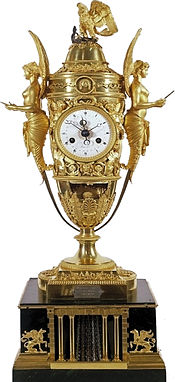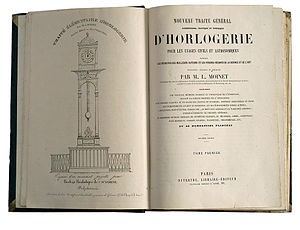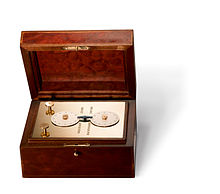Louis Moinet i Nicolas Mathieu Rieussec
- Autor: Master Yoda
- /
- Dodano: 24.03.2017
- /
- Kategoria: Perspektywa historyczna
- /
Co łączy tych panów, kim byli?
Louis Moinet, urodził się w 1768 roku w Bourges(Francja), studiował architekturę, malarstwo i rzeżbę we Włoszech.
Po powrocie do Francji zostal profesorem ASP w Luwrze. Jednak pasją jaką bylo zegarmistrzostwo ( bedąc mlodziencem cały wolny czas spędzał w zakladzie zegarmistrzowskim) dało znac o sobie-odnowił kontakty ze swoim mistrzem które doprowadziły do tego ze przeprowadził się na kilka lat do Szwajcarii by szlifować swoje umiejętności. W 1811 roku spotkał się w Paryżu z Abrahamem Louisem Breguetem ( kazdy pewnie wie, ale to on wynalazł min tourbillon)- który był juz znaną osobistością, został jego osobistym doradcą, panowie wspólpracowali razem aż do smierci Breugeta w 1823 roku.
Czym się własciwie wyróznił i zasłuzyl na przypomnienie? A mianowicie był autorem wielu wspaniałych wynalazkow, którymi nie ustępował samemu wielkiemu Breugetowi! I tak na potrzeby obserwacji astronomicznych opracował pierwszy na swiecie chronograf ( błędna nazwa, ale o tym pózniej) "Computeur de tierces" wyposazony równiez w pierwszy na swiecie szybkobiezny mechanizm 30Hz ( 21600A/h). Pomyślmy, to 1816 rok, 30 Hz kieszonkowy zegarek, brzmi to trochę jak scienice fiction zegarmistrzowskie. I tak było do 2012 roku gdy zegarek pojawł się nienaruszony po ponad 150 latach na aukcji organizowanej przez dom Christie's-nabył go Jean-Marie Schaller, CEO i odnowiciel marki Louis Moinet, legendarny zegarek do tego czasu opisywany tylko w dziele Moineta.




Ponizej wykonany w 1806 roku zegar dla Napoleona, to 8 dniowiec ze wskazaniem godziny, minut, daty, oraz co wyjatkowe -faz ksiezyca umieszczonych wewnątrz wskazówki kalendarza (kość słoniowa)

Warto tez wspomniec o zegarach wykonanych dla Thomasa Jeffersona, Jamesa Monroe (prezydenci USA). Jest autorem encyklopedii zegarmistrzowskiej 'Traite d'Horlogerie' (1848) opisujacej najbardziej wyrafinowane i pomysłowe techniki zegarmistrzowskie.


Teraz pora na Nicolasa Mathieu Rieussec.
To urodzony 20 lipca 1781 roku francuski zegarmistrz do 2003 roku uznawany za wynalazce chronografu. ( moim zdaniem nieslusznie pozbawionym tej chwały, ale o tym za chwile). Jako krolewski zegarmistrz mial wielkie możliwosci, postanowil opracowac zegar do pomiaru czasu na wyscigach konnych ( jego brat, Nicolas Joseph był wazna osoba we francuskich kręgach jezdzieckich), do tej pory mozna było zmierzyc czas zwyciezcy, natomiast czas po jakich linie mety przekraczały kolejne konie był trudny do zmierzenia.
W 1821 roku opracował chronograf umozliwiajacy taki pomiar, a mianowicie podczas pomiaru wystarczylo naciskać przycisk-wciąż obserwujac wyscig, a na tarczy pozostawal ślad atramentu...
Ponizej szczególy z posiedzenia Francuskiej Akademi Nauk ( 12 pażdziernika 1821) dotyczące zasad działania wynalazku:
”The volume and shape of this instrument are about those of a large pocket chronometer. The dial is movable and turns about an axis that is perpendicular to its plane and passes through its centre. When the Chronograph is operating, this dial makes one revolution per minute, and since its circumference is divided into 60 parts, the angular motion of one division corresponds to one second. A small window next to the hanging ring reveals a number, which is replaced by another number with each revolution of the dial and indicates the minutes; the Chronograph can run about three-quarters of an hour without stopping.
To use this instrument, when it is mounted and in a resting state, one first sets the divisions marking the time to the starting points by turning a knurled knob with one’s hand. Through the intermediary of a gear train, the knob causes the minute and second dials to move. Having done this, when the moment to start timing arrives, one presses a small button next to the knob to set the machine in motion. The observer can give full attention to the phenomena whose successive time intervals he wishes to measure, and as soon as one of the divisions of these intervals is reached, he presses a second button next to the one we have just mentioned. At the moment when it is pressed a small pen, or metal point, passing through the open tip of a cone filled with black oil ink and placed opposite the moving dial’s fixed zero point, marks a point on the circumference that is divided into seconds. This point then indicates the second and fraction of a second corresponding to the beginning or end of the period of time being measured. Operation of the pen trigger mechanism neither stops nor slows the moving dial’s motion, so the button can be pressed several times while this motion lasts, making a number of black points on the scale divided into 60 parts; each point indicates, by its position, the moment when it was marked. To stop the chronograph quickly, one need only press the button that started it. The mechanism is arranged such that pressing this button abruptly changes the current state of the machine, making it pass from a resting state to movement or from movement to its resting state. We did not examine the inside of the instrument, and we do not think that it offers anything particularly remarkable, given the current state of watchmaking. Its principal merit lies in its ability to instantly indicate the first and last moments of several successive time intervals by means of permanent, visible signs on a moving dial, without requiring the attention of the observer’s eyes or ears. A chronograph with such a property unquestionably offers precious resources to physicians, engineers and, in general, anyone who measures phenomena. A highly satisfactory trial was recently made at public horse races; but its use can obviously extend to an infinite variety of other kinds of observations, the testing of moving machines, gauging of running water, and almost all hydraulic operations. The passage of a star over the cross-hairs of a telescope, when the astronomer has only one free hand, will be very precisely indicated by this new means, which will either serve to verify the count of the seconds on a clock, or will replace such a count if the distant location of the clock or poor hearing keeps the escapement from being heard. […]'
I sam chronograf

No i w tym momencie drogi Moineta i Rieusseca sie zbiegają...
A mianowicie w terminologii zegarmistrzowskiej komplikacja chronografu to nic innego jak stoper.
Moim zdaniem to błąd. Chrono, a właściwie chronos to czas, graph-zapisywanie ( czasomierz Rieusecca pozostawial graficzny slad na tarczy po odmierzeniu odcinka czasu) a wiec zasadnym jest użycie n określenia chronograf, natomiast genialny w swojej konstrukcji i wyprzedzajacy swoją epokę wynalazek Moineta chronografem nie jest ( jak i inne zegarki nazywane 'chronografami") moim zdaniem ta komplikacja powinna nosić nazwę "chronoskopu" (chronoscope).
(Marka Louis Moinet gosciła w Warszawie: http://zegarkiipasja.pl/artykul/826-zegarki-louis-moinet-w-salonie-ferrari).
Wspomnieć warto na koniec o Adolphe Nicole który opatentował w 1844 roku "chronograf" umożliwiający zmierzenie nie tylko pojedynczego odcinka czasu za jedynym pomiarem, ale kilku odcinków z przerwami, dzięki możliwości zatrzymania i wznowienia pomiaru. Wielki rozwoj technologiczny tej komplikacji umożliwiło zastosowanie jej podczas działan wojennych-głownie przez lotnicwo i artylerię.
- Doceń i poleć nas:

poprzedni
Szalona sobota z KMZiZ. Część 1.
następny
Szalona sobota z KMZiZ. Część 2.